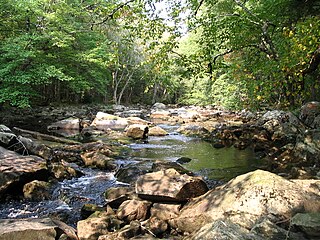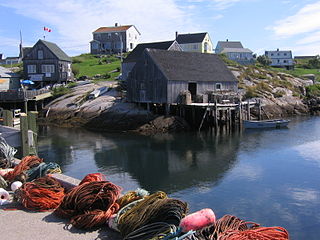
Kejimkujik National Park is a National Park of Canada, covering 404 km2 (156 sq mi) in the southwest of Nova Scotia peninsula. It consists of two separate land areas: an inland part, which is coincident with the Kejimkujik National Historic Site of Canada, and the Kejimujik National Park Seaside on the Atlantic coast.

Halifax, formally known as the Halifax Regional Municipality (HRM), is the capital of the Canadian province of Nova Scotia. It had a population of 403,131 in 2016, with 316,701 in the urban area centred on Halifax Harbour. The regional municipality consists of four former municipalities that were amalgamated in 1996: Halifax, Dartmouth, Bedford, and Halifax County.

Peggy's Cove is a small rural community located on the eastern shore of St. Margarets Bay in Nova Scotia's Halifax Regional Municipality, which is the site of Peggys Point Lighthouse.

Spryfield is an unincorporated suburban community in Halifax, Nova Scotia, Canada. It was founded about 1770, by Captain William Spry, who purchased land there and established the settlement with the aid of stationed soldiers from the nearby Halifax garrison. In 1783, he sold the property and returned to England. The name "Spryfield" is also sometimes used to refer to the general area of Halifax's South Mainland, which includes a number of communities along the Herring Cove and Purcell's Cove Roads.

The Halifax Peninsula is a community and planning area located in the urban core of municipal Halifax, Nova Scotia. Halifax Peninsula is home to Downtown Halifax, the financial and economic heart of the municipality, which was also the site of the original settlement and town of Halifax. The town of Halifax was founded by the British government under the direction of the Board of Trade and Plantations under the command of Governor Edward Cornwallis in 1749. Geographically, the Halifax Peninsula is a Canadian peninsula in central Nova Scotia.

Halifax Harbour is a large natural harbour on the Atlantic coast of Nova Scotia, Canada, located in the Halifax Regional Municipality.

Moraine State Park is a Pennsylvania state park on 16,725 acres (6,768 ha) in Brady, Clay, Franklin, Muddy Creek, and Worth townships in Butler County, Pennsylvania, in the United States.
Rockingham is a community located in Nova Scotia's Halifax Regional Municipality.
The Eastern Shore is a region of the Canadian province of Nova Scotia. It is the Atlantic coast running northeast from Halifax Harbour to the eastern end of the peninsula at the Strait of Canso.
The Halifax Regional Municipality (HRM) in Nova Scotia, Canada has a widely varied geography.
The Tobeatic Wilderness Area, located in Nova Scotia, Canada, is the largest protected area in the Canadian Maritimes. It is in the south western central part of the province, near Kejimkujik National Park. It was formerly known as the Tobeatic Wildlife Management Area, and the Tobeatic Game Reserve.

Timberlea is a community located on the rural/suburban fringe of the Halifax Regional Municipality in Nova Scotia, Canada, along the St. Margaret's Bay Rd, which extends from the Armdale Rotary to the Head of St. Margaret's Bay. It begins about 8 miles/13 km from downtown Halifax. The name means a broad meadow in a forest.

Long Lake Provincial Park is located in Halifax, Nova Scotia, Canada. It was initiated in 1981 by then Premier John Buchanan after Halifax's water supply had been shifted from the Spruce Hill/Long Lake/Chain Lakes watershed to the Pockwock Lake watershed near Hammonds Plains. The 2095-hectare park, formally established in 1984, constitutes the bulk of these former watershed lands. Other portions were deeded to the municipality of Halifax, and the area around the Chain Lakes is still administered by the Halifax Regional Water Commission, since the Chain Lakes remain the city's emergency water supply.

Fairview is a former community and current neighbourhood within the urban core of Halifax in Nova Scotia, Canada.

Beaver Bank is a suburban community northeast of Lower Sackville on the Beaver Bank Road within the Halifax Regional Municipality, Nova Scotia, Canada. It is about 35 kilometres from the City of Halifax.

West Dover, is a coastal fishing community located in the Halifax Regional Municipality in the Canadian province of Nova Scotia on the Chebucto Peninsula. West Dover is situated between Peggy's Cove and East Dover on Highway 333.
Leiblin Park, Nova Scotia is a residential neighbourhood in Halifax on the Mainland Halifax within the Halifax Regional Municipality, Nova Scotia.

East Bay is a bay of the Bras d'Or Lake on Cape Breton Island in the Canadian province of Nova Scotia. It lies entirely within Cape Breton County.

The Eastern Shore Granite Ridge, also known as the Musquodoboit Batholith, is a range of prominent hills averaging 100-125m (330-410ft) in height, located just inland from the Eastern Shore of Nova Scotia. Geologically, it is related to the much larger South Mountain Batholith, but the two are geologically distinct areas. Many of the hills have steep cliffs on one or more of their sides, some featuring vertical drops in excess of 50m (160ft); as a result, many of the taller hills offer extensive views despite their relatively low elevation.












